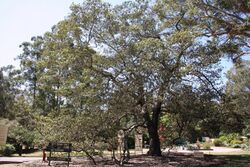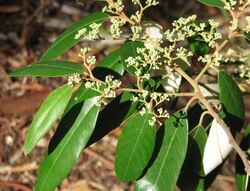Biology:Alphitonia excelsa
| Alphitonia excelsa | |
|---|---|

| |
| Scientific classification | |
| Kingdom: | Plantae |
| Clade: | Tracheophytes |
| Clade: | Angiosperms |
| Clade: | Eudicots |
| Clade: | Rosids |
| Order: | Rosales |
| Family: | Rhamnaceae |
| Genus: | Alphitonia |
| Species: | A. excelsa
|
| Binomial name | |
| Alphitonia excelsa (Fenzl) Benth.
| |
Alphitonia excelsa, commonly known as the red ash or soap tree, is a species of tree in the family Rhamnaceae. It is endemic to Australia , being found in New South Wales, Queensland, Northern Territory and the northeastern tip of Western Australia. It is used in bush regeneration as a pioneer species and for amenity planting.
Taxonomy and naming
Alphitonia excelsa was first described by Eduard Fenzl and reclassified by George Bentham. One of 20 species of the genus Alphitonia in Australia and the Pacific Islands, its specific epithet is derived from the Latin excelsus 'tall'.[1] Other common names include red almond,[2] silver leaf,[2] leatherjacket, white leaf, white myrtle, sarsaparilla tree, and coopers wood.
Description
This tree reaches a height of 7–25 metres (23–82 ft), by 5–10 metres (16–33 ft) across.[3] The red ash has a spreading shade-producing habit when a larger tree with an overall greyish green appearance. The alternate leaves measure 5–14 cm (2–5.5 in) in length and 2–5 cm (1–2 in) wide and are dark glossy green above and silvery with fine hairs underneath, making an attractive contrast on windy days. The trunk and larger branches bear fissured grey bark, while smaller branches have smoother grey or white bark. It bears small greenish white flowers in late autumn and early winter, followed by globular dark fruit around 1.5 cm (0.59 in) in diameter,[4] which contain two seeds. When young shoots are bruised, they give off a typical odour of sarsaparilla.[5] The flowers are fragrant in the evening.[3]
Distribution and habitat
It grows in eucalypt forests, eucalypt and acacia savannas, gallery forests and rainforests of NSW from Mount Gulaga (previously known as Mount Dromedary) northwards along the coast and inland to the Pilliga scrub, though Queensland and the Northern Territory and into the northwest of Western Australia.[6] Inland forms can be stunted in appearance. It prefers sandy soils.[citation needed]
Ecology
It serves as a food plant for the caterpillars of the moonlight jewel (Hypochrysops delicia),[7] and the caterpillars of the small green-banded blue (Psychonotis caelius taygetus).[8]
Uses
Trees are quick growing in cultivation.[4] This is an Australian ornamental tree, with some specimens of high visual appeal.[4] It may be used in amenity planting as a street tree providing shelter.[2] It has also been used in boat-building and cabinet making, its tough timber a light red or brown in colour.[3][4] It can be a fodder plant for sheep and cattle, and is a useful pioneer species in bush regeneration.[9] Indigenous Australians used the leaves as a soap due to the plant’s high saponin content.[10]
References
- ↑ Simpson DP (1979). Cassell's Latin Dictionary (5th ed.). London: Cassell Ltd.. pp. 883. ISBN 0-304-52257-0.
- ↑ 2.0 2.1 2.2 de Beuzeville, p. 110
- ↑ 3.0 3.1 3.2 Encyclopaedia of Australian Plants Suitable for Cultivation: Vol. 2. Port Melbourne: Lothian Press. 1985. p. 176. ISBN 0-85091-143-5.
- ↑ 4.0 4.1 4.2 4.3 de Beuzeville, p. 125
- ↑ ANBG staff (1976). "Growing Native Plants - Alphitonia excelsa". Australian National Botanic Gardens website. Australian National Botanic Gardens. http://www.cpbr.gov.au/gnp/gnp6/alph-exc.html. Retrieved 2008-04-24.
- ↑ Harden GJ (1990). "Alphitonia excelsa (Fenzl) Benth.". Plantnet - New South Wales Flora Online. Royal Botanic Gardens, Sydney. http://plantnet.rbgsyd.nsw.gov.au/cgi-bin/NSWfl.pl?page=nswfl&lvl=sp&name=Alphitonia~excelsa. Retrieved 2008-04-24.
- ↑ Braby, Michael F. (2005). The Complete Field Guide to Butterflies of Australia. Collingwood, Victoria: CSIRO Publishing. pp. 226. ISBN 0-643-09027-4. https://archive.org/details/The_Complete_Field_Guide_to_Butterflies_of_Australia.
- ↑ Fisher, Robert (1995). A Field Guide to Australian Butterflies. Chipping Norton, New South Wales: Surrey Beatty & Sons Pty Limited. pp. 254. ISBN 0-949324-52-3.
- ↑ HCCREMS (2005). "Coastal plant Regeneration:Red Ash - Alphitonia excelsa". Hunter and Central Coast Regional Management Strategy (HCCREMS) website. HCCREMS. Archived from the original on August 22, 2006. https://web.archive.org/web/20060822075841/http://www.lhccrems.nsw.gov.au/CPR/CPR/plant_profiles/a.excelsa.htm. Retrieved 2008-04-24.
- ↑ "Soap Tree" (in en). 2020-02-24. https://tooheyforesteec.eq.edu.au/support-and-resources/research/soap-tree.
Cited text
- de Beuzeville WAW (1947). Australian Trees for Australian Planting. Sydney: Forestry Commission of New South Wales/ A. H. Pettifer, Government Printer.
External links
- "Alphitonia excelsa". Australian Plant Name Index (APNI), IBIS database. Centre for Plant Biodiversity Research, Australian Government. http://www.anbg.gov.au/cgi-bin/apni?taxon_id=28728.
Wikidata ☰ Q4735331 entry
 |


